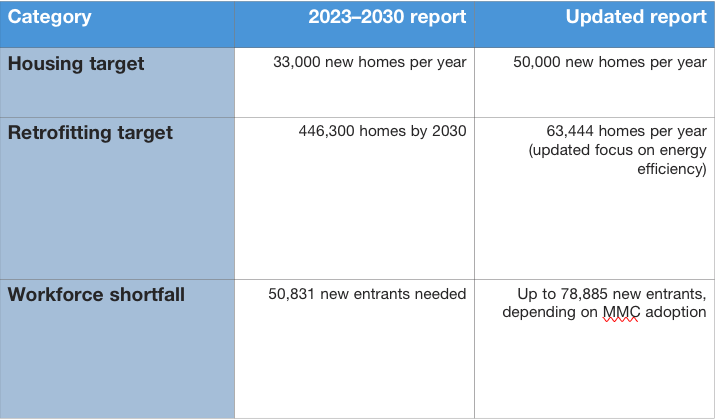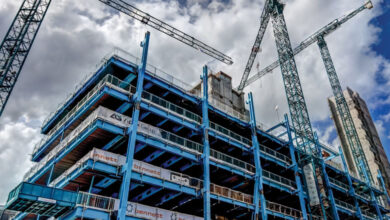New housing targets bring fresh retrofitting skills challenges

The Department of Further and Higher Education, Research, Innovation and Science has revised its projections of the number of workers needed for Ireland to successfully complete its retrofitting journey, owing to the Government’s new housing targets.
The revision of projected targets reflects new housing and sustainability targets, published by the previous government prior to the general election.
While a report in 2023, Report on the Analysis of Skills for Residential Construction and Retrofitting, 2023 to 2030, estimated a need for 50,831 new entrants, updated projections suggest even greater urgency due to increased housing targets and evolving construction methods.
The 2023-2030 report set a target of 33,000 homes per year and 446,300 retrofits by 2030. However, the new analysis, an updated Report on the Analysis of Skills for Residential Construction and Retrofitting, published in November 2024, raises these figures significantly, calling for the completion of 50,000 new homes annually and an increased rate of 63,444 home retrofits each year.
This adjustment reflects a growing gap between workforce capacity and national housing ambitions, emphasising the need for a more efficient and well-trained workforce.
Modern methods of construction and labour shortages
A key divergence between the two reports is the role of modern methods of construction (MMC). The 2023-2030 report does not account for increased usage of MMC, forecasting a 50,831 worker shortfall to meet targets.
The updated report, however, models two scenarios: one where non-MMC methods continue to predominate, requiring 78,885 additional workers, and another where a 24 per cent increase in productivity through MMC reduces the total number of required workers by 10,000. This shift highlights the growing importance of prefabrication and modular techniques in alleviating labour shortages while also signalling a need for upskilling and workforce adaptation.
Comparing the Governments’ two Skills for Residential Construction and Retrofitting reports
The updated analysis also brings a more detailed breakdown of workforce requirements, refining earlier projections. Compared to the previous report, the demand for electricians and plumbers has increased, largely due to the shift toward electrified heating systems and energy efficient retrofits. Conversely, the updated report says that trades such as roofing and glazing may see a decline as prefabricated building elements become more common.
The new report also identifies an urgent need for digital construction skills, particularly in areas like building information modelling (BIM) and smart energy installation. These trends reinforce the necessity for a workforce that is not just larger but more technologically skilled, moving away from a solely craft-based focus.
While both reports acknowledge the growing skills gap, the latest update provides clearer recommendations for bridging it. The focus is now on expanding apprenticeship programmes and ensuring greater collaboration between education providers and industry stakeholders.
Specialised training in zero-energy building techniques, solar installation, and heat pump systems is now seen as essential to addressing the shortage of qualified workers. There is also a stronger emphasis on fast tracking qualification pathways to address immediate labour shortages.
Demographic shifts
The new analysis also reflects changes in housing development trends. The 2023–2030 report had assumed steady growth in single-family homes, but the ESRI’s report Population Projections: structured housing demand and data from Census 2022 detail a significant shift toward apartment construction.
This requires more specialised training in high-density building techniques and a greater reliance on modular and off-site manufacturing, which in turn demands a different mix of skills than previously projected.
Another notable difference is the pacing of workforce expansion. The 2023-2030 report anticipated a sharp increase in workforce demand, whereas the updated report proposes a more gradual scale-up.
Housing completions are now expected to rise from 30,330 in 2024 to 63,000 by 2030, while retrofitting projects are projected to increase from 34,114 homes in 2024 to 89,422 by 2030.
This phased approach aims to mitigate the effects of labour shortages and ensure a more sustainable transition to higher activity levels, as failure to do so could overwhelm the sector with an immediate shortfall.
Ultimately, the updated Report on the Analysis of Skills for Residential Construction and Retrofitting reflects a more data-driven and technologically focused outlook compared to its predecessor owing to the new targets which account for MMC adoption, phased workforce growth, and digital skill integration, and arguably provides a clearer roadmap for meeting Ireland’s ambitious housing and sustainability goals.
However, as the new government takes office, it is unclear whether green policies will continue to be a top priority at government level, meaning that success will depend on swift and strategic investments in training, education, and industry collaboration to ensure the workforce can adapt to evolving construction methodologies.






